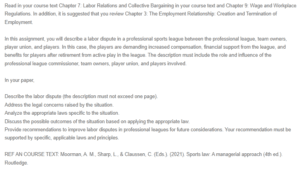Sports Law – Critical Analysis
Labor dispute
In 2004, the National Hockey League encountered a serious lockout that was considered the worst in professional sports history. The lockout led to the cancellation of the entire season. The number of games that were lost during this season was 1230. The players, fans and other stakeholders were not assured of another season the following year as the issues were not yet resolved. However, a collective agreement was arrived at in July 2005, and the new season started on time. The key issues that led to the lockout and subsequent season cancellation included minimum salaries, free agency, high fines for players’ misbehavior, revenue sharing, salary arbitration process operations, and playoff bonuses (Kobritz & Levine, 2013).
Subsequently, the final agreement offered players a salary cap. Despite not wanting this result, the players ceded to this agreement. However, the cap’s adjustment would occur annually, depending on revenue. The agreed minimum payroll was valued at $21 million. The newcomers would earn $850,000 each season and a 10 percent annual bonus. The National Hockey League players were also expected to deposit a certain portion of their salaries into an escrow holding like the National Basketball League players do. The funds held in Escrow will be distributed to the teams whenever the season’s payroll is 54 percent more than the revenue. In contrast, the accounts shall be remitted to the players whenever the total payroll is 54 percent less than the revenue (Staudohar, 2005). Further, other conclusions included liberalization of free agency and drug testing policies that were non-existent before.
Legal Concerns and Recommendations
Various legal issues were revealed during the lockout. For instance, players are entitled to competitive remuneration. The revenue that hockey players make tends to be lower than other games. Sharing revenue was contentious because players seemed distraught by the existent sharing proportions. The increasing costs of players pushed both owners and teams to advocate for a certain share of the revenue. The second highlighted issue was the requirement to place money in Escrow. This was perceived as being forced to plow money back into the team in case some teams exceeded the budgets. The lack of cost certainty in the previous Collective Bargaining Agreements fueled the fallout significantly. The union continually rejected the proposed salary caps because it considered the owners’ reporting methods regarding revenue untrustworthy. These issues were directly connected to the sport’s laws that govern contracts, collective bargaining agreements, free agency, union representation, and renegotiation of the contracts by individuals (Kobritz & Levine, 2013).
The contract law requires clear statements on salary adjustment agreements, reporting bonus amounts, bonus payment times, final year salaries, and roster bonuses (Kobritz & Levine, 2013). Therefore, the unions and the owners were obliged to ensure that the hockey league players had contracts that contained these aspects and more. The negotiation option was also necessary and required by law. The outcome that would not have led to the league’s cancellation was bargaining with the union on behalf of the players and ensuring all the highlighted aspects were clear.
In addition, the players were entitled to raise their grievances because of the unfair labor practices that each identified. The owners sought to protect their interests while the union intended to represent the players’ rights. The process of establishing the various rules that secured the players’ financial resources abided with the contract law that requires a consideration for the other party’s efforts (airSlate Legal Forms, Inc., 2022). Therefore, the decision to review the payments annually observed the legal requirements.
References
airSlate Legal Forms, Inc. (2022). Sports Contracts – Basic Principles.
Kobritz, J. I., & Levine, J. F. (2013). Armageddon II: An Analysis of the Issues Surrounding the NHL Lockout. American Journal of Management, 13(1), 53-65.
Staudohar, P. D. (2005). The hockey lockout of 2004-2005. Monthly Labor Review, 23-29.
ORDER A PLAGIARISM-FREE PAPER HERE
We’ll write everything from scratch
Question
Read in your course text Chapter 7: Labor Relations and Collective Bargaining in your course text and Chapter 9: Wage and Workplace Regulations. In addition, it is suggested that you review Chapter 3: The Employment Relationship: Creation and Termination of Employment.

Sports Law – Critical Analysis
In this assignment, you will describe a labor dispute in a professional sports league between the professional league, team owners, player union, and players. In this case, the players are demanding increased compensation, financial support from the league, and benefits for players after retirement from active play in the league. The description must include the role and influence of the professional league commissioner, team owners, player union, and players involved.
In your paper,
Describe the labor dispute (the description must not exceed one page).
Address the legal concerns raised by the situation.
Analyze the appropriate laws specific to the situation.
Discuss the possible outcomes of the situation based on applying the appropriate law.
Provide recommendations to improve labor disputes in professional leagues for future considerations. Your recommendation must be supported by specific, applicable laws and principles.
REF AN COURSE TEXT: Moorman, A. M., Sharp, L., & Claussen, C. (Eds.). (2021). Sports law: A managerial approach (4th ed.). Routledge.

